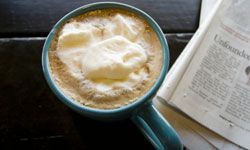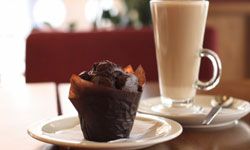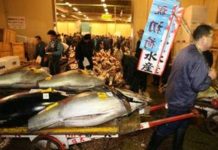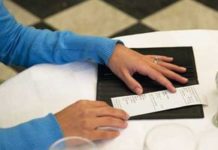 “What isn’t she telling you?Jupiterimages/Brand X Pictures/Thinkstock
“What isn’t she telling you?Jupiterimages/Brand X Pictures/Thinkstock
Let’s face it. If you’re a coffee person, then your barista is one of the most important people in your life. On many a foggy morning and brain-dead afternoon, this man or woman — this wizard — has served up all the liquid energy your body longed for. Espressos. Lattes. Mochas. Cappuccinos. Hot. Iced. Flavored. You’ve sampled every caffeinated concoction at the café.
But have you ever wondered what this wizard might be hiding? Is he or she telling you everything there is to know about those coffee wares? Probably not. Lean in close and we’ll tell you what the wizard won’t.
Contents
- Your Favorite Drinks are Loaded With Calories
- There's a Markup on Your Beverage
- You Can Buy Pricey Drinks for Cheap
- Some Places Have Secret Menu Items
- It Makes Them Sad When You Don't Tip
- The Espresso Machine Might Be Dirty
- Coffee Does Not Have an Indefinite Shelf Life
- Non-fat Milk Makes Better Foam
- All Fair Trade Coffee Isn't Equal
- You'll Want to Put That Muffin Down
10: Your Favorite Drinks are Loaded With Calories
If you drink black coffee or coffee with low fat milk, you don’t need to worry much about calorie intake. But if you regularly spoil yourself with some of the fancier coffee beverages, you might want to take a closer look at the calorie count. Any beverages with whole milk, whipped cream or flavored syrups will have a lot of calories:
- A McDonald’s large mocha has 400 calories.
- The Venti White Chocolate Mocha at Starbucks contains 580 calories.
- A Dunkin’ Donuts frozen cappuccino with whole milk has a whopping 610 calories.
So remember to treat those high-calorie coffee drinks as dessert — not something you eat every day, but delicious on occasion. For your daily cup of joe, opt for skim milk and "just say no" to whipped cream and flavored sugary syrups.
9: There's a Markup on Your Beverage
 “There’s a 900 percent markup on your cup of joe.iStockphoto.com/Thinkstock
“There’s a 900 percent markup on your cup of joe.iStockphoto.com/Thinkstock
Buying your daily cup of coffee at the local coffee shop might be convenient, and it may even seem affordable. But after you find out how much retailers mark up the price of coffee, you might start making it at home. In fact, you might want to start making it at home and selling it to your neighbors for a profit!
If you buy coffee every day, and that coffee costs you between $1.50 and $1.95 a cup, you’ll spend around $700 a year on your java habit. The coffee shop, on the other hand, only spends about 15 to 20 cents on your cup of coffee. So, that’s about a 900 percent markup. And that doesn’t even take into account the other items you might pick up at the coffee shop — muffins, doughnuts, biscotti.
8: You Can Buy Pricey Drinks for Cheap
Now that you know how much your coffee shop is marking up its beverages, you might be tempted to find creative ways to save money. Turns out there are some sneaky means to getting your favorite coffee drinks on the cheap.
You didn’t hear it from us, but…
- You can order off the kids’ menu if you’re looking for something like hot apple cider or hot chocolate. The kid-sized portions are usually a pretty large.
- Make "the poor man’s latte." An iced latte at Starbucks is made of two espresso shots, milk and ice, and it costs around $3.50. Instead of ordering that, order a double espresso on ice, which is only about $2. Then just add milk from the condiment bar.
We warn you, though, your barista might take offense if try to beat the system. A more polite way to save a buck is to bring your own cup to the coffee shop. Many shops will give a small discount to people who bring their own reusable mugs.
7: Some Places Have Secret Menu Items
 “Order something that’s not on the menu, and see if they give it to you!JupiterImages/Photos.com/Thinkstock
“Order something that’s not on the menu, and see if they give it to you!JupiterImages/Photos.com/Thinkstock
We’ve all heard about restaurants with "secret" menu items — things not listed on the menu that you can order by name. For example, In-n-Out Burger offers secret menu items like Animal Style or Protein Style. Jamba Juice offers secret flavors like Strawberry Shortcake, Fruity Pebbles and PB&J.
The coffee giant Starbucks is no different. The company has confirmed none of these items. Nevertheless, here they are:
- Red Eye: shot of espresso added to a regular coffee
- Black Eye: two shots of espresso added to a regular coffee
- French pressed coffee: any ground coffee served in a French press
- Chocolate Cream Frappuccino: need we say more?
Try ordering one of these and let us know what happens!
6: It Makes Them Sad When You Don't Tip
Many people feel resentful when they see a tip jar at the coffee shop. "Why should I tip someone for doing his job?" they think. "It’s not like he brought the drink to my table or anything." Baristas, of course, make the counter argument: "Well, you tip your bartender, don’t you? So why wouldn’t you tip your barista?"
The majority of baristas count on tips to supplement their salaries. And a great barista will make you a great coffee. It’s an art — how finely to grind the beans, the milk-to-foam ratio, how hard to tamp the grinds, and also how to make those cool designs in the latte foam. Shouldn’t all that hard work be rewarded? If you’re torn about whether or not to tip your barista, ask yourself the following questions: Did he or she put a lot of work into the drink? Did the barista provide excellent service? If the answers are "yes," then go ahead and tip — especially if you’re a regular at the shop. It never hurts to be known as a good tipper.
5: The Espresso Machine Might Be Dirty
 “A clean machine makes for a quality shot of espresso.iStockphoto.com/Thinkstock
“A clean machine makes for a quality shot of espresso.iStockphoto.com/Thinkstock
If you really love the coffee at your favorite shop, chances are you have a great barista who knows how to keep an espresso machine clean. Unfortunately, not everyone keeps their machines as clean as they should. If you have a home espresso machine, you should remember to clean yours, too.
Coffee beans contain oils. Those oils are what make your espresso so rich and delicious. However, these oils also go rancid over time. When espresso runs through the machine, the oils cling to the water screen and any brass surfaces, and the oils also can leave a film on the machine’s filter. Eventually, the film will even start plugging up the holes in the filter basket and create deposits. All this affects the taste of your brew.
Some people recommend cleaning the espresso machine every 20 to 30 shots. Of course, at a busy coffee shop, bustling baristas probably don’t get the opportunity to do this. But do make sure that they clean their machines on a regular basis.
4: Coffee Does Not Have an Indefinite Shelf Life
Contrary to what you might think, coffee isn’t a shelf-stable product — it doesn’t stay fresh indefinitely. If your coffee shop isn’t grinding its coffee fresh on a daily (or even hourly) basis, chances are you’re drinking some stale coffee, which means diminished flavor.
The roasting process is what releases the oils in the coffee bean and gives you the deep, rich coffee taste. Coffee beans reach their peak one to three days after roasting, and then the flavor starts to deteriorate. Fresh-roasted coffee should be used within a week, or 10 days at the most. A good barista will grind beans as needed. Once you grind those beans, you’re opening up the coffee to go stale. Coffee beans and ground coffee should be stored in a dark, cool, dry place and never in the fridge or freezer.
3: Non-fat Milk Makes Better Foam
 “It’s still a mystery how they make that pretty design in the froth on top.Hemera/Thinkstock
“It’s still a mystery how they make that pretty design in the froth on top.Hemera/Thinkstock
Generally, if you enjoy a good coffee drink, you’ll get the best flavor from whole milk. Many coffee gourmands won’t even consider using anything less than whole milk in their beverages. More milk fat equals more flavor — it’s as simple as that. Interestingly, though, more milk fat also means decreased foam. Foam (or frothed milk) is what you see on the top layer of a cappuccino. If you like a foam mustache with your first sip of cappuccino, then ask for skim milk, not whole.
2: All Fair Trade Coffee Isn't Equal
Did you choose your coffee shop based on its "fair trade" coffee? Fair trade ensures that the people producing the coffee profit fairly when they sell their beans to a big company. In this way, people in developing countries aren’t taken advantage of by the free market. It’s a good thing.
However, as with any product, the buyer should beware. For the bigger, national chains, using Fair Trade-certified coffee isn’t a decision motivated by conscience — it’s a decision motivated by the bottom line. If a store’s ethical stance is important to you, make sure they carry those values throughout their entire business and product line. Also, make sure the coffee you’re purchasing is actually Fair Trade-certified. Some corporations have started marketing their coffees with certifications that sound a lot like Fair Trade, but actually aren’t.
1: You'll Want to Put That Muffin Down
 “Consider a chocolate muffin a dessert treat, not a healthy breakfast.iStockphoto.com/Thinkstock
“Consider a chocolate muffin a dessert treat, not a healthy breakfast.iStockphoto.com/Thinkstock
Your coffee shop probably doesn’t carry just coffee. Most likely it offers a plethora of other delicious treats, like muffins, pastries, cupcakes and scones. It’s tempting to grab a quick breakfast as you pick up your morning coffee. But think twice before you make a habit of this. We already talked about product markups, and baked goods are no different.
More importantly, though, these treats are loaded with calories and fat. Many of the items in that bakery case are over-sized, with multiple servings hiding in one big blueberry muffin. For example, take Starbucks’ crumb cake. One piece of this cake contains 670 calories. 670 calories! That’s more than a Big Mac, people. And a Starbucks date and oatmeal bar may sound healthy, but it’s packed with 500 calories. If you’re watching your waistline, you’re better off passing on these.
For more about coffee and other foods and drinks, check out the links on the next page.
Lots More Information
Related Articles
- 10 Tips for Making the Perfect Cupcakes
- 10 Things Your Grocer Doesn’t Want You to Know
- 5 Great Kitchen Toys for Summer Cooking
- Top 10 Unexpected Cake Ingredients
- 5 Tips for Baking the Perfect Cookie
Sources
- Conradt, Stacy. "The Quick 10: 10 Secret Menu Items." Mental_floss. Aug. 31, 2009. (Aug. 28, 2010) http://www.mentalfloss.com/blogs/archives/33297
- Duse, Eleanor. "How Restaurant Markups Work." TLC Cooking. Apr. 9, 2009. (Aug. 28, 2010) https://recipes.howstuffworks.com/menus/restaurant-markups2.htm
- Echlin, Helena. "An Espresso to Grind." Chowhound. Mar. 27, 2007. (Aug. 28, 2010) http://www.chow.com/food-news/53900/an-espresso-to-grind/
- "Espresso Cleaning: Why, How, and When." Home-Barista.com. 2010. (Aug. 28, 2010) http://www.home-barista.com/espresso-machine-cleaning.html
- Lantry, Devon. "Full Starbucks secret menu." Examiner.com. 2010. (Aug. 28, 2010) http://www.examiner.com/chain-restaurant-in-national/full-starbucks-secret-menu
- "Milk Frothing Guide – Hello Milk!" CoffeeGeek.com. 2010. (Aug. 28, 2010) http://coffeegeek.com/guides/frothingguide/milk
- Richardson, Jill. "Does Fair Trade Coffee Lift Growers Out of Poverty or Simply Ease Our Guilty Conscience?" Alternet. Feb. 11, 2010. (Aug. 28, 2010) http://www.alternet.org/food/145555/does_fair_trade_coffee_lift_growers_out_of_poverty _or_simply_ease_our_guilty_conscience
- "Starbucks Food." HoneyLine.com. Jan. 25, 2010. (Aug. 28, 2010) http://www.thehoneyline.com/food/calorie-management/starbucks-food
- "Storing Coffee Beans – How To Store Coffee Beans." What’s Cooking America. 2010. (Aug. 28, 2010) http://whatscookingamerica.net/Q-A/CoffeeStoring.htm
- Tickle, Cindy. "Starbucks 101: What is a barista?" Examiner.com. 2010. (Aug. 28, 2010) http://www.examiner.com/starbucks-in-national/starbucks-101-what-is-a-barista
- "The 5 Worst Coffee Drinks in America." Today. Aug. 31, 2009. (Aug. 28, 2010) http://today.msnbc.msn.com/id/32478989/









































